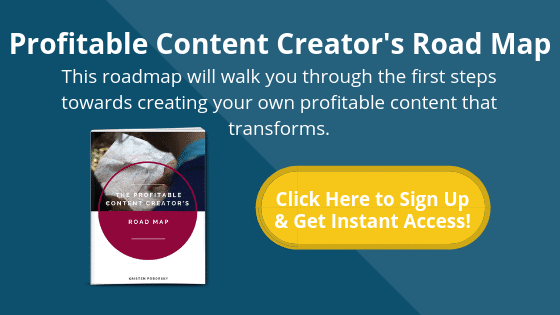Creating Content is one of the BEST ways to position yourself as the “Go-To” person in your niche and fill your coaching practice.
However, there is a RIGHT way and a WRONG to do this…This ONE thing is so simple and when you combine it with my proven framework for content creation it will change the way you create content.
The best thing is that when you use this framework you only need to create one piece of content a week to see results.
Step One: Create content that matters to your audience and gets them into a buying state of mind.
You must get inside your ideal client’s mind. Here are 3 questions your content must address when creating content that matters:
- What are they struggling with?
- How can you help them?
- What are proven topics that they are interested in?
I want you to create content that has been fully researched and is a proven topic that your ideal client is interested in.
I don’t want you to copy other people’s content, just take popular topics and make them your own. Write your content from your unique point of view.
Mastering this is key to getting seen and heard online.
It’s how we took a relationship coach’s business from single six figures to multiple six figures. We researched topics, tried a variety of them, and discovered in the process a very profitable niche. It was one that people were and still are willing to pay a lot of money to solve this problem.
When you start creating content that actually matters to your audience they’re going to actually start consuming more and more if ut, Start this process by picking content categories that align with your business and then do the research.

Step Two: Your content must position you as the go-to person in your niche
When you do this, your content helps you grow your coaching practice and provides value.
How you position yourself as a go-to person in your niche? There are 3 key types of content that help you do this:
- How-to content
- Thought reversal content
- Case studies
If I were wanting to position myself in my niche using content, I would create a mix of these three types of content.
How to content should be teaching content
But, you don’t want to give away the whole how-to. I would really position this type of content more as what to do and not go into the detailed steps.
This kind of content really needs to stay behind your pay wall for your paper products and services.
Thought reversal content goes against conventional wisdom in your niche.
This is a very interesting concept that I learned from a friend of mine. Thought reversal content is when you really differentiate yourself by going against conventional wisdom in your niche.
I’ll bet in your niche there are lots of people saying the same thing and what you want to do is to go against what most people are saying inside your niche and explain why.
This is really how you position yourself as a thought leader and differentiate yourself from everyone else in your niche.
Case Study content must tell a story that showcases your expertise.
The final piece of content that will help you position yourself as the go-to person is those case studies.
It is super important you have a number of case studies in your content stable. In this content, you showcase and tell a client story of how you solved a problem.
You want to tell them before, during, and after story of their transformation.
And if you want to really get people excited, film a short video interview and insert that into your content. If you can’t get a video or use their name because of confidentiality, don’t worry.
You can still change the names and tell the story of how you helped them. When you show people how you have helped, they start to see that it is possible for them and see you as the natural choice to get those same results.
Case studies are probably some of the most valuable types of content you can create. because you can use them in your marketing material and for lunches and also out on social media.
Step Three: Your content must lead them to your products and services.
This is super important because your content is the key way you can grow your coaching practice. When you combine this content creation strategy along with one and two here when you need to make sure that your content aligns with your products and services.
Basically what I’m saying here is that you do not want to be creating content around topics that don’t relate to what you are teaching in your programs and if you got a coaching practice what you’re coaching to your clients it really must align with what your services are.
However, there’s a caveat here… I don’t want you to give away when you’re creating this kind of content.
All of the specifics should be behind your paywall. Like I said in number two…create content about what to do and not how to do it.
If you can create a lot of what to do content that will really help them get interested and excited about your products and services. Always take the opportunity to casually mention that you teach how to do these things that you’re talking about in your content either in a program or in your services.
I would be remiss if I didn’t include this bonus tip:
You need to make sure you have a format, a process for creating your content. There are 5 parts to creating a successful piece of content.
- Include a title
- Add an introduction
- Make your content easy to scan
- Wrap it all up with a conclusion
- Add a call to action! Give them the next steps that you want them to take.
Let’s wrap everything up again here for you:
There are 3 Things You Must Do To Create Profitable Content
Step One: Create content that matters to your audience and gets them into a buying state of mind.
You must get inside your ideal client’s mind. Here are 3 questions your content must address when creating content that matters:
- What are they struggling with?
- How can you help them?
- What are proven topics that they are interested in?
Step Two: Your content must position you as the go-to person in your niche
How you position yourself as a go-to person in your niche? There are 3 key types of content that help you do this:
- How-to content
- Thought reversal content
- Case studies
Step Three: Your content must lead them to your products and services.
When you combine this content creation strategy along with one and two here when you need to make sure that your content aligns with your products and services.



